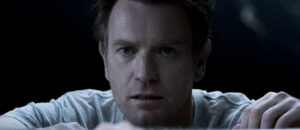First Man
Movie Rating:
4.5
Since we first looked up to the sky and saw that giant shiny orb, humans have been fascinated with the moon. It became the center of cultures and religions, dictating calendars and governing forces it would take us millennia to comprehend. The goal of stepping foot upon it would take another conceptual leap, one that mixes ingenuity, tenacity and wanderlust with equal measure. It’s this spirit of achievement, and the costs incurred, that drives Damien Chazelle’s remarkable First Man.
Ostensibly, this is the story of Neil Armstrong, a complicated man with impeccable aeronautic acumen whose outward appearance expressed calm while his interior was often far more tumultuous. In the film, we see his rise from test pilot to astronaut to lunar explorer, each aspect of his career shaped not only by a nation’s desire to one-up the Russians, but equally his own private, obsessive drive to be as comprehensively competent as possible.
Ryan Gosling is an inspired choice to bring Armstrong’s story to the screen. Like few others, the actor is able to convey much with subtlety. Projected on a giant, IMAX-sized canvas, his micro-expresivity and moments of interiority are a perfect foil for the magnitude of the quest, colliding these intimately human moments with the celestial scope of his mission.
Visually, Chazelle’s film is jaw-dropping, a sublime recreation of the period down to the rivets on the outside of the spacecraft or the perfect shade of amber, mustard and orange that decorates the bungalows. Like ornate, courtly period pieces, this is show-off production design, but that does little to take away from the precision with which the team manages to replicate Armstrong’s world to the finest degree.
Chazelle shot the film on a constellation of formats – 8mm, 16mm, 35mm, VistaVision and IMAX – and by switching grain structure and aspect ratio it forms a kind of mosaic of the various aspects of Armstrong’s life. The grand reveal of full IMAX is one of the film’s most epic moments, and to see the movie on anything less than a proper, 1.43:1 screen is to rob it of some of its majesty.
Beyond the sheer spectacle is a highly humanist story, where the technology has its automation overridden by the deft touch of a sympathetic commander, or the tragedy of an accident must be confronted not just as a technical blip but an emotional hurdle. Neil’s wife Janet (Claire Foy) outwardly expresses this ambivalence, but her character is the least satisfying in the film. Foy does well with little, but there’s only so much that can be done on the domestic front against the backdrop and scope of the rest of the story.
Better is the use of Corey Stoll as Buzz Aldrin, an astronaut that is the bigger-than-life cliché one would expect to be the focus not only of the film but the entire mission. His snarkiness is obnoxious but always on-point. This brash, no-nonsense acumen and bravado contrast effectively with Armstrong’s quietude.
In a pivotal scene, Neil finds out he’s to be the commander of the mission. It takes place in the bathroom, and when the news is given it’s done with little fanfare or buildup. He’s told, the news is accepted, and looking into a mirror we look for outwards signs of reaction. In Gosling’s eyes we see, or believe we see, flashes of excitement and dread, but for Armstrong this is another data point to be considered among many.
This outward calm against the magnitude of events sets the film up as a real treat that never holds Armstrong as somehow robotic, but instead as a character with a deep capacity for crushing his anxieties inward. When the moments do flash (including an excessively polite call for quiet while calculating), we see that Chazelle is drawing a picture of the man with great subtlety, deftly getting behind the façade to see the fragility of the man.
Chazelle draws from the usual suspects. Echoes of 2001, The Right Stuff, and even Apollo 13 are inevitable. Borrowing much from Kubrick’s finale, the first-person perspective elements most speak to the film’s mission. The opening launches are all from inside the capsule, a blizzard of streaming lights and crunching sounds witnessed from within. When Armstrong exits the Eagle, the film opens up, literally and metaphorically, and we see the event not from one small man, but as an achievement for all of us.
This is hard stuff to pull off, and many will be wowed by the wonder or miss some of the subtleties at play. For the viewers open to what’s at play, this is another excellent film from a director unafraid to mix moments big and small, often combining them in unexpected but effective ways.
First Man is first-rate, a wonderful addition to the canon that provides a nuanced look at this most reticent of astronautic heroes. Its flaws are few and easily overlooked. The film provides both an intimate character portrait and a triumphant spectacle like few in the history of the medium.




Deaditelord
I’m on the fence about seeing this. While the subject matter interests me, I usually find the use of the Paul Greengrass handheld shaky cam technique to be VERY annoying/distracting (it’s my biggest pet peeve with the Bourne movies) and from what I’ve heard it’s used a lot throughout the film. How bad is it?
Elizabeth
It’s pretty bad. There’s probably about 7 minutes that aren’t shaky cam, but 6 minutes and 30 seconds of that is the end credits. Find a theater with a bar, have a couple of stiff drinks before the show, and then you won’t be able to tell if the picture is moving or if you’re just swaying from intoxication.
I can’t understand how the reviewer calls this visually jaw-dropping. It’s often blurry, extremely grainy, out of focus from extreme closeups, and just nauseatingly in constant motion from the hand camera work.
William Henley
That in and of itself is enough to make me not want to see the movie. Last thing I want to see is shaky cam on an IMAX screen. There is a time and place for it, but it should be limited to a scene or scenes, not used for an entire movie.
The subject matter has been done before, and with excellent results, and without vertigo-cam.
njscorpio
I’m glad I read this exchange, I hated what Greengrass did to the Bourne franchise with that shakey cam.
EM
Damn it, now I want a chocolate shake, and I can’t get one at this hour.